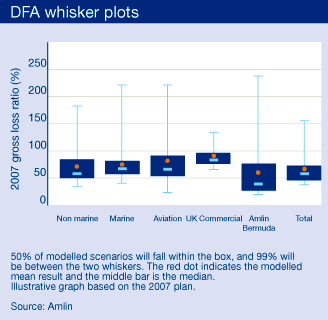Review
Risk management – effectively understanding and governing risk
Development of Enterprise Risk Management
The economic, or dynamic financial analysis (DFA), model is a key enterprise wide stochastic tool which enables us to analyse the potential economic performance of the business. The resulting output allows us to consider the best estimate result for the various components of our business (such as individual insurance risk classes) and also to consider the range of possibilities around the mean. This is an invaluable tool in the assessment of business risk. Using the best estimate reserve levels for historical performance and detailed claims data, and through predicting the levels of premium income and rating, the model is used to forecast business performance for future years.
For the past five years the model has been used to evaluate and score the business planning forecasts provided by the underwriting divisions. The model recognises the value of diversification inherent in writing a number of non-correlating classes of business. A key benefit of this approach is to enable us to understand what the changes to one component of business or asset class mix, has on the overall potential of the business.
From the DFA model, we are able to run simulations of potential underwriting result outcomes. The box whisker chart above shows the loss ratio distribution of each Syndicate division, for Amlin Bermuda and the Group as a whole. The combination of the divisions shows the benefit of diversification with the volatility of the Group result less than the volatility of any one divisional result.

The RAM team are also responsible for reviewing and reporting on the Group’s realistic disaster scenarios. Every quarter the underwriting divisions (using in house catastrophe modelling capability and proprietary models as appropriate) conduct a stress test of approximately 30 major catastrophe events. These events, which include, but are not limited to, those prescribed by the Lloyd’s Franchise Performance Department, are used to examine our gross and net exposure to major catastrophe events.
The actuarial team also conduct a quarterly assessment of reserving risk comparing carried reserves with their best estimate outcome. This analysis is used to compare year on year reserving and provide assurance on the consistency of carried reserves. Furthermore, using a methodology known as ‘bootstrapping’, a broad assessment of the risk and probability of reserve inadequacy is carried out.
Plans for further development of risk management
In 2008 we aim to have completed the implementation of the new risk management system and the adoption of a new framework for analysis. This will include a further evaluation of risk pre and post mitigating controls and it will enable us to more quickly report on the status of risk against a more detailed appetite.
In 2008 we will commence more detailed risk based analysis of our investments.
The development of our economic model will include regular enterprise wide reporting of the key measures of profit and risk.
